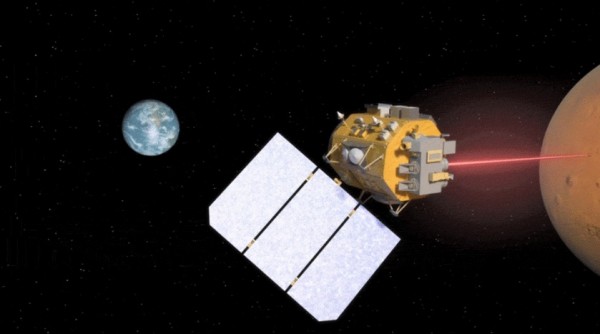By Ana Verayo, | March 27, 2017

Conceptual illustration depicting a satellite using lasers to relay data from Mars to Earth.
NASA is now planning to establish a new high speed internet space connection communications system. The space agency also aims to boost current global communications technologies in order to help astronauts in communicating faster and more efficiently during future missions to the moon and Mars.
Like Us on Facebook
NASA officials say that the LCRD (Laser Communications Relay Demonstration) can help further explore laser communications systems and to enable higher data rates and connections between Earth. More specifically this involves communications between ground based communications to spacecraft and scientific data downlink including astronaut communications.
According to Steve Jurczyk of NASA's Space Technology Mission Directorate, LCRD will be the next step in using optical communications for near Earth and deep space missions. Apart from this, this type of technology can potentially transform space communications overall, with the help of NASA's Human Exploration and Operations Mission Directorate's Space Communications and Navigation arm, MIT Lincoln Laboratories and the United States Air Force.
Optical communications or laser communications enable data encoding via a beam of light and shooting lasers from a spacecraft back to mission ground control on Earth. NASA also says that this new technology is 10 to 100 times more efficient than radio frequencies, which is the mode of communications used in space missions today.
LCRD's main advantage is that laser communications systems only require smaller equipment compared to radio systems. This means that spacecraft designs can now become smaller, lighter and have lesser power requirements.
According to director Don Cornwell of the Advanced Communication and Navigation division of NASA's Space Communications and Navigation program office, a laser terminal will be designed for the International Space Station to enable data relay from space station and back to Earth. This process will be completed using speeds of gigabit per second data rates by 2021. Once tested, many Earth orbiting NASA missions can now relay data through LCRD back to Earth.
The LCRD system will be placed in geosynchronous orbit that will operate for a maximum period of five years. This payload will involve two identical optical terminals that are connected to a space switching unit, that will serve as a data router. The ground terminals will be located in California and Hawaii, installed with laser modems that can allow digital data translation from radio frequency signals to laser and vice versa.
According to LCRD's principal investigator, Dave Israel, with the LCRD, we will have the opportunity to test the capabilities of laser communications and test its performance during different weather conditions and times of day. The LCRD will be launched in mid 2019.
-
Use of Coronavirus Pandemic Drones Raises Privacy Concerns: Drones Spread Fear, Local Officials Say

-
Coronavirus Hampers The Delivery Of Lockheed Martin F-35 Stealth Fighters For 2020

-
Instagram Speeds Up Plans to Add Account Memorialization Feature Due to COVID-19 Deaths

-
NASA: Perseverance Plans to Bring 'Mars Rock' to Earth in 2031

-
600 Dead And 3,000 In The Hospital as Iranians Believed Drinking High-Concentrations of Alcohol Can Cure The Coronavirus

-
600 Dead And 3,000 In The Hospital as Iranians Believed Drinking High-Concentrations of Alcohol Can Cure The Coronavirus

-
COVID-19: Doctors, Nurses Use Virtual Reality to Learn New Skills in Treating Coronavirus Patients







